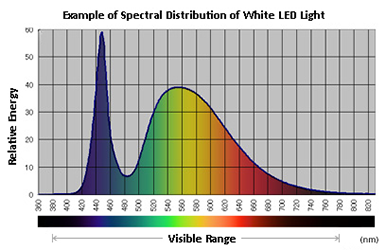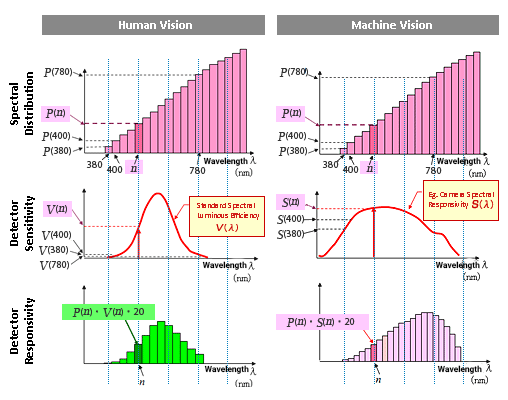Theory of Light and Color

1. The Human Eye vs. Machine Vision:
Defining "Brightness"
In the world of machine vision image processing, the terms "bright" and "dark" are often used. However, they do not have the same meanings as they do when speaking about human vision. This is because the nature of "light" that defines "brightness" is different.
"Brightness" and the Human Eye
The sensations known as “bright” and “dark” are felt through the human eye due to the light incident on the human eye stimulating the retina. In other words, the concept of light and the concept of brightness were relative to the senses of the human eye.
Through technological advances, the concept of light has expanded beyond the original meaning of human sense. The light perceived by the human eye is visible light in the wavelength range from 380 nm to 760 nm. Scientific developments have found that visible light is a type of electromagnetic wave ≪1≫, part of a broader electromagnetic spectrum that is not entirely visible to the human eye. It has become clear that there are electromagnetic waves that have the same physical properties as light.
These wavelengths, known as ultraviolet and infrared, are now included within the concept of light together with visible light. Ultraviolet is electromagnetic wavelengths that are shorter than those the human eye perceives as purple (360 to 400 nm). ≪2≫ Infrared refers to wavelengths longer than those that appear red in the visible range (760 to 830 nm).


With this understanding, "light" has two definitions: one that is restricted to what the human eye can see and one that defines light broadly as pure physical energy.
In addition, the human eye does not have uniform sensitivity to all wavelengths in the visible range, and its sensitivity is highest (feels bright) in the middle of the visible range, and becomes lower (feels darker) towards the ends. ≪3≫
"Brightness" and Machine Vision
Photographic film, image sensors, and various optical sensors are also capable of sensing light. However, their sensitivity to wavelengths, as well as the degree of sensitivity, can be highly distinct compared to the human eye and each other. ≪4≫
In machine vision, the brightness captured in the image depends on the characteristics of the image sensor and the camera. Light itself also has various states, and depending on how much energy is present at each wavelength from the ultraviolet region to the infrared region (spectral distribution characteristics), the strength of the stimulus that the machine’s "eye" receives is different. ≪5≫
If energy is high in the wavelength range where the sensor has high sensitivity, the image will appear bright. On the other hand, if energy is high in the wavelength range where the sensitivity is low, the image will be darker. For example, an infrared camera (which has sensitivity only in the infrared range) can capture an image that is invisible to the human eye.

In conclusion, brightness depends on the spectral distribution of light and the wavelength sensitivity of each component in a machine vision system. ≪6≫
Definitions of "Light"
While the definition of light is narrow in the sense of human vision, when used in the context of machine vision, the range of the spectrum that is visible is much wider depending on the sensor’s sensitivity. "Light” is restricted to the visible spectrum when it comes to human vision, but for machine vision, the definition of “light” extends from ultraviolet to infrared. This difference is key to understanding what can be achieved with machine vision.
Comment
≪1≫ Electromagnetic waves
Electromagnetic waves are explained in more detail in the next chapter.
≪2≫ nm (nanometer)
Electromagnetic waves have the property that energy propagates while repeatedly vibrating, like ocean waves, radio waves, and sound waves. Since light is also a type of electromagnetic wave, it exhibits these wave-like properties. The Greek letter λ (lambda) represents wavelength, and the unit of measure is typically nm (nanometer).
1 nm = 10-9 m = 1 billionth of a meter
For example, a wavelength that is 500 nanometers is 1/2 millionth of a meter.
≪3≫ Wavelength sensitivity characteristics of the human eye to "light"
The wavelength sensitivity characteristics of the human eye with respect to light varies slightly between individuals, and factors such as physical and mental health also have an impact. However, standard spectral luminous efficiency is used as a universal standard to represent this characteristic objectively and quantitatively. Standard spectral luminous efficiency curves are defined by the average response of a large number of human observers. The standard spectral luminous efficiency as a function of wavelength is represented by the symbol V (λ).

≪4≫ Wavelength sensitivity characteristics of machine vision
The spectral response characteristic describes the sensitivity of a photosensor (camera, film, etc.) to different wavelengths λ. Notation is S (λ). V (λ) is a specific case of S (λ).
≪5≫ Spectral distribution of light
Represented as P (λ), spectral distribution is the characteristic that shows the energy distribution state for each wavelength of light (every 1 nm). Here are examples of the spectral distribution for familiar light sources.




≪6≫ Brightness depends on both light and detector
The wavelength sensitivity characteristic of the human eye (standard spectral luminous efficiency) is called V (λ), and the wavelength sensitivity characteristic of the eye of a photosensor such as a camera is called spectral responsivity, represented as S (λ).
Here is an example of graphing these characteristics by dividing them by 20 nm.
Focusing on a certain wavelength section (n), the energy of light P (n) × 20 in this wavelength width section (20 nm) is detected by the detector as V (n) or S (n). In other words, the amount of stimulus (response amount) received by the detector in this section is P (n) × V (n) × 20 or P (n) × S (n) × 20.
The total amount of stimulus received by the detector is the sum of all stimulus amounts in each wavelength section, so the total area of the bar graph is the brightness that the detector senses.
For simplicity, the spectral distribution of "light" is the same, and the spectral responsivity characteristics of the detector are shown in the sample comparison of human and machine vision. In general, the spectral distribution varies depending on the type of light, so brightness is determined by the product of the spectral distribution P (λ) of light and the spectral response S (λ) of the detector.

The Human Eye vs. Machine Vision:
Defining "Brightness"

